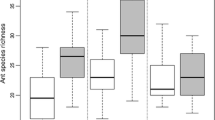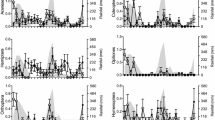Abstract
The present study investigated the impacts of rainforest clearance, and associated subsequent land␣use for pasture, on assemblages of soil and litter arthropods in eastern subtropical Australia. We assessed the utility of soil and litter arthropods as potential bio-indicators of cleared and forested habitats. Arthropods were sampled from 24 sites (12 sites each in rainforest and pasture) using two methods (extraction from litter, pitfall traps). Responses of taxa were analysed at various levels of taxonomic resolution, including ‘coarse’ arthropods (all arthropods sorted to Order/Class), ant genera and ant species. Multivariate analyses of arthropod composition indicated that an increase in the level of taxonomic resolution did not provide a commensurate increase in the sensitivity of assemblage response. Indicator values (IndVals), computed for each taxon, showed that a number of arthropod taxa may have potential as bio-indicators of habitat change. However the use of many of these, especially many ant species found in our study, may be unreliable because even after extensive numbers of sites were sampled, most species showed patchy distributions. To overcome this problem, we generated ‘composite indices’, by combining information from sets of indicator taxa. The utility of these composite indices is discussed.
Similar content being viewed by others
References
Adam P (1992) Australian Rainforest. Oxford University Press, Oxford
Alonso LE (2000) Ants as indicators of diverstiy. In: Agosti D, Majer JD, Alonso LE, Schultz TR (eds) Ants: standard methods for measuring and monitoring biodiversity. Smithsonian Institution Press, Washington, pp 80–88
Andersen AN (1986) Diversity, seasonality and community organization of ants at adjacent heath and woodland sites in south-eastern Australia. Aust J Zool 34:53–64
Andersen AN (1991) Sampling communities of ground-foraging ants: pitfall catches compared with quadrat counts in an Australian tropical savanna. Aust J Ecol 16:273–279
Andersen AN (2000) The Ants of Northern Australia: a guide to the monsoonal fauna. CSIRO Publishing, Collingwood
Andersen AN, Majer JD (2004) Ants show the way Down Under: invertebrates as bioindicators in land management. Front Ecol Environ 2:291–298
Andre HM, Noti MI, Lebrun P (1994) The soil fauna: the other last biotic frontier. Biodivers Conserv 3:45–56
Aoki J, Harada H (1982) Environmental change and soil fauna in east Kalimantan (Borneo). Bull Inst Environ Sci Technol, Yokohama National University 8:341–378
Basset Y, Novotny V, Miller S, Springate NE (1998) Assessing the impact of forest disturbance on tropical invertebrates: some comments. J Appl Ecol 35:461–466
Clarke KR (1993) Non-parametric multivariate analyses of changes in community structure. Aust J Ecol 18:117–143
Dufrene M, Legendre P (1997) Species assemblages and indicator species: the need for a flexible asymmetrical approach. Ecol Monogr 67:345–366
Frith D, Frith C (1990) Seasonality of litter invertebrate populations in an Australian upland tropical rain forest. Biotropica 22:181–190
Ghilarov MS (1977) Why so many species and so many individuals can coexist in the soil. Ecol Bull 25:593–597
Giller PS (1996) The diversity of soil communities, the ‘poor man’s tropical rainforest’. Biodivers Conserv 5:135–168
Greenslade P, New TR (1991) Australia: conservation of a continental insect fauna. In: Collins NM, Thomas JA (eds) The conservation of insects and their habitats. Academic Press, London, pp 33–70
Greenslade PJM (1973) Sampling ants with pitfall traps: digging-in effects. Insectes Soc 20:343–353
Gubby C (1994) Campbellville and Cedar Days: a compiled history of the former south-east Queensland sawmilling township of Campbellville and pioneers of the associated timber industry during the latter part of the 19th century. Department of Primary Industries, The State of Queensland
Kaspari M (1996) Litter ant patchiness at the 1-m2 scale: disturbance dynamics in three neotropical forests. Oecologia 107:265–273
Kitching RL (1993) Towards rapid biodiversity assessment— lessons following studies of arthropods of rainforest canopies. In: Rapid Biodiversity Assessment. Proceedings of␣the␣Biodiversity Assessment Workshop Macquarie University—1993. Research Unit for Biodiversity and Bioresources, Sydney, pp26–30
Kremen C, Colwell RK, Erwin TL, Murphy DD, Noss RF, Sanjayan MA (1993) Terrestrial arthropod assemblages: their use in conservation planning. Conserv Biol 7:797–808
Lawton JH, Bignell DE, Bolton B, Bloemers GF, Eggleton P, Hammond PM, Hodda M, Holt RD, Larsen TB, Mawdsley NA, Stork NE, Srivastava DS, Watt AD (1998) Biodiversity inventories, indicator taxa and effects of habitat modification in tropical forest. Nature 391:72–76
Lewinsohn TM, Freitas AVL, Prado PI (2005) Conservation of terrestrial invertebrates and their habitats in Brazil. Conserv Biol 19:640–645
McGeoch MA, van Rensburg BJ, Botes A (2002) The verification and application of bioindicators: a case study of dung beetles in a savanna ecosystem. J Appl Ecol 39:661–672
Moran MD (2003) Arguments for rejecting the sequential Bonferroni in ecological studies. Oikos 100:403–405
Myers N, Mittermeier RA, Mittermeier CG, da Fonseca GAB, Kent J (2000) Biodiversity hotspots for conservation priorities. Science 403:853–858
Nakamura A, Proctor H, Catterall PC (2003) Using soil and litter arthropods to assess the state of rainforest restoration. Ecol Manag Restor 4 (supplement):S20–S28
Petal J (1978) The role of ants in ecosystems. In: Brian MV (eds) Production ecology of ants and termites, vol 13. Cambridge University Press, Cambridge, pp 293–325
Pik AJ, Oliver I, Beattie AJ (1999) Taxonomic sufficiency in ecological studies of terrestrial invertebrates. Aust J Ecol 24:555–562
Rainio J, Niemela J (2003) Ground beetles (Coleoptera: Carabidae) as bioindicators. Biodivers Conserv 12:487–506
Reichle DE (1977) The role of soil invertebrates in nutrient cycling. Ecol Bull 25:145–156
Roback PJ, Askins RA (2005) Judicious use of multiple hypothesis tests. Conserv Biol 19:261–267
Sakaino M, Harada H, Bae TW (2002) An index of naturalness based on soil animal communities of environmental protection forests. Eco-habitat 9:119–127
Sala OE, Chapin FS, Armesto JJ, Berlow E, Bloomfield J, Dirzo R, Huber-Sanwald E, Huenneke LF, Jackson RB, Kinzig A, Leemans R, Lodge DM, Mooney HA, Oesterheld M, Poff NL, Sykes MT, Walker BH, Walker M, Wall DH (2000) Global biodiversity scenarios for the year 2100. Science 287:1770
Soares SM, Schoereder JH (2001) Ant-nest distribution in a remnant of tropical rainforest in southeastern Brazil. Insectes Soc 48:280–286
Sodhi NS, Koh LP, Brook BW, Ng PKL (2004) Southeast Asian biodiversity: an impending disaster. Trends Ecol Evol 19:654–660
United Nations Department of Economic and Social Affairs (2002) Global Challenge Global Opportunity: Trends in Sustainable Development. The United Nations Department of Economic and Social Affairs for the World Summit on Sustainable Development, Johannesburg
Veech JA, Crist TO, Summerville KS (2003) Intraspecific aggregation decreases local species diversity of arthropods. Ecology 84:3376–3383
Watt AD, Stork NE, Eggleton P, Diane S, Bolton B, Larsen TB, Brendell MJD, Bignell DE (1997) Impact of forest loss and regeneration on insect abundance and diversity. In: Watt AD, Stork NE, Hunter MD (eds) Forests and insects. Chapman & Hall, London, pp 273–286
Wilson EO (1958) Patchy distribution of ant species in New Guinea rain forests. Psyche 65:26–38
Acknowledgements
This study would not have been possible without the generous support of the people from Maleny. We are also grateful to Barung Landcare, Alan Andersen, Bill McDonald, Scott Piper, Heather Proctor and Cas Vanderwoude for assistance and advice. Thanks also to our volunteer workers for field and laboratory assistance. We thank anonymous reviewers who improved this manuscript. This research was supported by the Queensland Government’s Growing the Smart State program.
Author information
Authors and Affiliations
Corresponding author
Rights and permissions
About this article
Cite this article
Nakamura, A., Catterall, C.P., House, A.P.N. et al. The use of ants and other soil and litter arthropods as bio-indicators of the impacts of rainforest clearing and subsequent land use. J Insect Conserv 11, 177–186 (2007). https://doi.org/10.1007/s10841-006-9034-9
Received:
Accepted:
Published:
Issue Date:
DOI: https://doi.org/10.1007/s10841-006-9034-9




